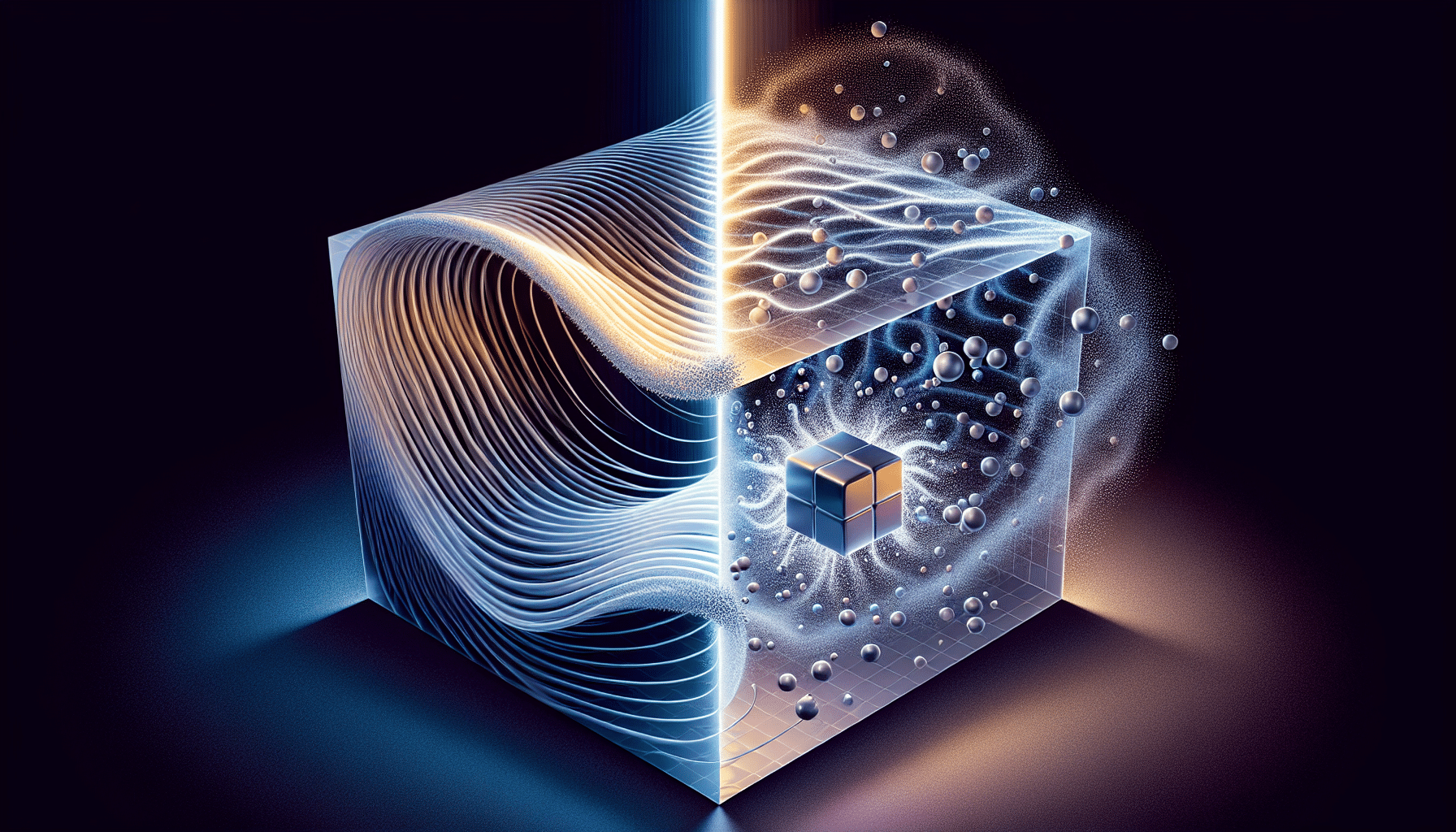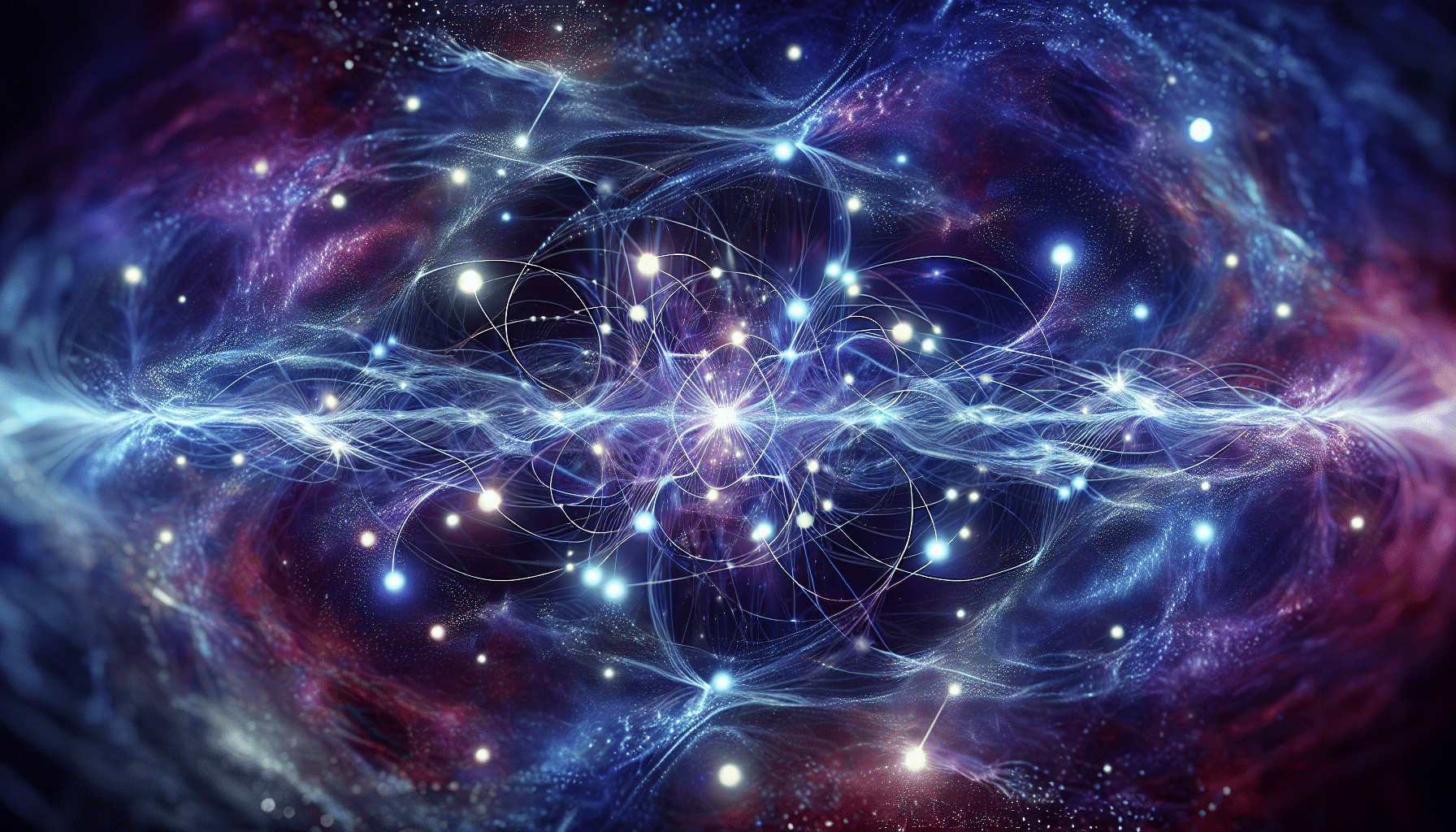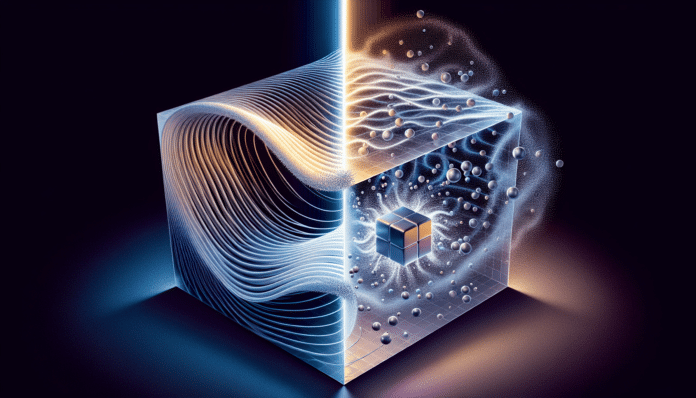Quantum physics uncovers a universe where particles exist in superpositions, communicate instantly across any distance, and tunnel through barriers. We explore these phenomena and more in ‘the world of quantum physics strange and fascinating phenomena.’ From the birth of quantum theory to mind-bending concepts like wave-particle duality and quantum entanglement, discover the revolutionary ideas that challenge our classical understanding and promise to transform technology.
Key Takeaways
- Quantum theory originated from Max Planck’s discovery that energy is quantized into discrete units, which revolutionized our understanding of energy and matter and led to the development of quantum mechanics.
- Wave-particle duality challenges classical physics by demonstrating that quantum entities like light and electrons exhibit both particle and wave properties depending on the experimental conditions, fundamentally altering our understanding of the quantum world.
- Quantum superposition allows particles to exist in multiple states simultaneously until observed, exemplifying the counterintuitive nature of quantum physics and posing significant challenges for scientists in understanding quantum measurement and reality.
The Birth of Quantum Theory
An unexpected revelation from Max Planck’s work on blackbody radiation marked the dawn of quantum theory. Initially aiming to support continuous theories of physics, Planck stumbled upon the revolutionary idea that energy is quantized into discrete units, which he termed quanta. This groundbreaking hypothesis introduced the concept that energy levels are not continuous but exist in specific packets, fundamentally altering our understanding of energy and matter.
The derivation of Planck’s constant (h), a cornerstone of quantum mechanics that describes the quantization of energy, resulted from Planck’s quantization of energy. This constant is pivotal in calculating the energy of photons, the particles of light. Planck’s work laid the foundation for a new era in physics, setting the stage for further exploration into the quantum realm.
Albert Einstein proposed the concept of light quanta, or photons, suggesting that light itself is quantized, thereby expanding on Planck’s hypothesis. This bold idea provided an explanation for the photoelectric effect, wherein light particles eject electrons from metals, a phenomenon that classical physics could not explain. Einstein’s insights earned him a Nobel Prize and cemented the notion that energy is indeed quantized.
Together, the pioneering efforts of Max Planck and Albert Einstein opened the floodgates to a new way of thinking about the subatomic world. Their theories not only explained previously puzzling phenomena but also laid the groundwork for the development of quantum mechanics, a field that continues to unravel the mysteries of the universe.
Wave-Particle Duality: The Double Nature of Light and Matter

One of the most intriguing aspects of quantum physics is wave-particle duality, which reveals that quantum entities, such as two particles of a quantum particle type, exhibit properties of both particles and waves, depending on the experimental conditions. This duality challenges the classical concepts that once seemed unshakeable, suggesting that our traditional understanding of particles and waves is insufficient to describe quantum behavior.
In the 19th and early 20th centuries, light was primarily understood to exhibit wave-like behavior, evidenced by phenomena such as interference and diffraction. However, the discovery that light also behaves like particles, called photons, turned this understanding on its head. The realization that light could exhibit both wave and particle properties was a monumental shift in physics.
Electrons, initially thought to behave solely as particles, were later found to exhibit wave-like properties through experiments such as the Davisson–Germer experiment in 1927. This experiment empirically confirmed the wave nature of electrons, supporting Louis de Broglie’s proposal that all matter could be considered as waves. These findings were pivotal in shaping the field of quantum mechanics.
The implications of wave-particle duality extend far beyond light and electrons. It fundamentally alters our understanding of the quantum world, where subatomic particles exhibit behaviors that defy classical logic. This duality is a testament to the complex and often paradoxical nature of quantum physics, inviting us to rethink the very fabric of reality.
Quantum Superposition: Being in Multiple States at Once
Objects like electrons and photons can exist in multiple states simultaneously until observed, thanks to quantum superposition, a cornerstone of quantum mechanics. This phenomenon is akin to flipping a coin and having it be both heads and tails at the same time, a concept that defies common sense and classical physics.
In the quantum world, quantum waves are mathematical equations that describe the probabilities of an object existing in different states. When an electron is in superposition, it can be thought of as having various possible outcomes, each with a specific probability. This concept is mathematically represented by equations with multiple solutions, similar to solving x² = 4 where x can be 2 or -2.
Some physicists advocate for the ‘many worlds’ interpretation, which posits that all possible outcomes of a quantum experiment occur simultaneously but in separate, distinct universes. This interpretation suggests that at the moment of measurement, reality fractures into multiple copies of itself, a process known as decoherence.
Measurement in the quantum world is fundamentally different from classical physics. For instance, when photographing an electron, the act of measurement significantly affects its location or speed, highlighting the strange nature of quantum superposition and the challenges it poses for scientists.
Quantum Entanglement: Spooky Action at a Distance

Entangled particles remain interconnected regardless of distance, influencing each other instantaneously, as per the phenomenon of quantum entanglement. Albert Einstein famously described this as “spooky action at a distance” due to its non-intuitive and perplexing nature. Recent advancements, such as Princeton physicists achieving entanglement between individual molecules for the first time in 2023, highlight the ongoing exploration of this phenomenon.
Using techniques like laser cooling and optical tweezers, researchers can control individual molecules and create entanglement. This allows entangled molecules to interact simultaneously, even if they are miles apart or at opposite ends of the universe. Such discoveries continue to push the boundaries of our understanding of quantum systems and their potential applications.
The development of quantum computers, which rely on quantum entanglement to perform complex calculations, hinges on this crucial phenomenon. A two-qubit gate that entangles two molecules is a fundamental building block for digital quantum computing and complex material simulation. This entanglement allows for superpositions to be linked with those of other objects, leading to mathematically related outcomes.
Quantum computers, fundamentally based on quantum entanglement, have the potential to revolutionize technology by solving problems that classical computers find impossible. Moreover, entanglement plays a significant role in developing quantum simulators and sensors, further showcasing its importance in advancing our technological capabilities.
The implications of quantum entanglement extend beyond theoretical physics, offering practical applications that could transform various fields. As researchers continue to unravel its mysteries, the potential for new discoveries and innovations remains boundless.
The Uncertainty Principle: Limits of Knowing
The Heisenberg uncertainty principle in quantum mechanics underscores that there is a limit to how precisely certain pairs of properties can be known simultaneously. This principle underscores the inherent uncertainty in measuring certain aspects of a system. For example, the more accurately we know an electron’s speed, the less precisely we can determine its location. This principle challenges our classical understanding of measurement and highlights the inherent limitations in observing quantum systems.
The uncertainty principle asserts that the product of the uncertainty in a particle’s position and the uncertainty in its momentum cannot be less than one-half of the reduced Planck constant. This relationship also applies to other pairs of physical quantities, such as energy and time. The principle emphasizes the wave-like nature of matter, as better localization of position increases the uncertainty in momentum.
Heisenberg’s uncertainty principle is:
- Not due to imperfections in measurement tools
- But is a fundamental property of quantum systems
- This principle reveals that the act of measurement itself affects the system being observed
- A concept that is counterintuitive to classical physics.
The uncertainty principle has profound implications for our understanding of the quantum world. It underscores the limitations of knowing and challenges us to rethink the very nature of reality. As we continue to explore the quantum realm, this principle remains a cornerstone of quantum mechanics, guiding our investigations and shaping our understanding of the universe.
Quantum Tunneling: Passing Through Barriers

Particles can penetrate potential barriers that appear impenetrable according to classical mechanics, as per the phenomenon of quantum tunneling. This process cannot be explained by classical physics and is a purely quantum mechanical effect. The probability of a particle tunneling through a barrier depends exponentially on the barrier’s width and height.
In the realm of stars, quantum tunneling plays a vital role in nuclear fusion, allowing particles to overcome the Coulomb barrier at lower temperatures. This process is essential for the fusion reactions that power stars, including our sun, demonstrating the significance of quantum tunneling in the cosmos.
Beyond its astronomical importance, quantum tunneling has practical applications in technology. Devices like tunnel diodes and scanning tunneling microscopes rely on this phenomenon to function. These applications showcase the tangible impact of quantum mechanics on our daily lives, bridging the gap between theoretical physics and practical innovation.
Schrödinger’s Cat: The Famous Thought Experiment

The paradox of quantum indeterminacy is illustrated by Schrödinger’s cat, a famous thought experiment. Proposed by Austrian physicist Erwin Schrödinger in 1935, the experiment involves a cat placed inside a sealed steel chamber with a Geiger counter, a bit of radioactive substance, and a flask of poison. If a radioactive atom decays, the Geiger counter triggers the release of poison, potentially killing the cat.
The crux of the experiment is that until the box is opened and observed, the cat is simultaneously alive and dead, existing in a superposition of states. This paradox challenges our classical understanding of reality and highlights the strange nature of quantum phenomena.
Schrödinger designed this thought experiment as a critique of the Copenhagen interpretation of quantum mechanics, which suggests that quantum systems exist in superpositions until measured. The thought experiment aims to show that quantum indeterminacy can lead to absurd results when applied to macroscopic objects.
Despite its simplicity, Schrödinger’s cat continues to provoke debate and discussion among physicists. It underscores the unresolved questions in quantum mechanics and serves as a powerful illustration of the complexities and paradoxes inherent in the quantum world.
Quantum Computing: Revolutionizing Technology

Leveraging the principles of quantum mechanics to perform computations far beyond the capabilities of classical computers, quantum computing heralds a technological revolution. At the heart of quantum computers are qubits, which are the quantum states of an object within a quantum system. These qubits can exist in superpositions, allowing quantum computers to process vast amounts of information simultaneously.
Quantum computers utilize algorithms designed to solve problems that classical computers might find impossible to compute. For example, Robert Raussendorf’s work on contextuality has shown that this property is necessary for a quantum computer to outperform a classical computer at certain tasks. This highlights the unique capabilities of quantum computing.
The concept of quantum supremacy refers to the ability of a quantum computer to perform tasks that are infeasible for classical computers. Achieving and maintaining superposition states long enough to carry out calculations before decoherence occurs is one of the critical challenges in this field.
As research and development in quantum computing progress, the potential for new breakthroughs in technology and science grows. Quantum computers have the promise to revolutionize fields ranging from cryptography to materials science, offering unprecedented computational power and opening new frontiers of innovation.
Quantum Fluctuations and the Universe
Linked to the Heisenberg uncertainty principle, quantum fluctuations played a key role in shaping the universe’s large-scale structure during the Big Bang. These minute fluctuations were magnified to cosmic scales during the universe’s exponential expansion, known as cosmic inflation. This early cosmic process set the stage for the distribution of matter and the formation of galaxies.
Inflation theory, developed in the late 1970s and early 1980s by physicists such as Alexei Starobinsky, Alan Guth, and Andrei Linde, provides a mechanism for explaining why the universe appears isotropic, with evenly distributed cosmic microwave background radiation. The theory suggests that during the rapid expansion, quantum fluctuations were stretched to macroscopic scales, seeding the formation of the universe’s structure.
These fluctuations also contribute to the universe’s flat geometry and help explain the absence of magnetic monopoles, further supporting the inflationary model. The hypothetical field responsible for this inflation, known as the inflaton, remains a topic of intense research and speculation.
The study of quantum fluctuations offers profound insights into the origins of the universe and the fundamental processes that shaped its evolution. As we continue to explore the cosmos, these quantum phenomena provide a bridge between the micro and macro scales, linking the subatomic world to the vastness of the universe.
Practical Applications of Quantum Mechanics
Despite its abstract and often counterintuitive nature, quantum mechanics has given rise to numerous practical applications, revolutionizing various fields. One of the most well-known applications is in medical imaging, with MRI scanners relying on quantum mechanics to produce detailed images of the human body. This technology has become indispensable in modern medicine, enabling non-invasive diagnostics and treatments.
Lasers, another product of quantum phenomena, are ubiquitous in today’s technology, used in everything from communications to cutting-edge scientific research. Solar cells, which convert sunlight into electricity, operate on principles of quantum mechanics, contributing to the growing field of renewable energy. These applications showcase the tangible benefits of quantum theory in advancing technology and addressing global challenges, making the realm of science fiction a reality.
Electron microscopes, which provide high-resolution images of tiny structures, utilize quantum effects to achieve their remarkable precision. Atomic clocks, essential for GPS and timekeeping, are based on quantum mechanics and provide the accuracy needed for various applications, including navigation and scientific research.
The impact of quantum mechanics extends to secure communications, advanced materials, and beyond. As we continue to harness the principles of quantum physics, the potential for new innovations and applications remains vast, underscoring the importance of this field in shaping the future of technology and society.
Summary
Throughout our journey into the quantum world, we have explored a range of phenomena that challenge our classical understanding of reality. From the birth of quantum theory with Planck and Einstein to the strange behaviors of wave-particle duality and quantum superposition, each aspect of quantum mechanics offers a glimpse into a realm where the rules of classical physics no longer apply.
Quantum entanglement, Heisenberg’s uncertainty principle, and quantum tunneling further illustrate the enigmatic nature of the quantum world, revealing interconnected particles, limits of knowing, and particles passing through barriers. Thought experiments like Schrödinger’s cat highlight the paradoxes and unresolved questions that continue to intrigue physicists.
The practical applications of quantum mechanics, from medical imaging to quantum computing, demonstrate the profound impact of this field on technology and society. As we strive to achieve quantum supremacy and unlock the full potential of quantum computers, the future promises exciting advancements and new frontiers in science and innovation.
As we conclude our exploration, it is clear that quantum physics not only deepens our understanding of the universe but also drives technological progress. The mysteries of the quantum world invite us to continue our quest for knowledge, pushing the boundaries of what is possible and inspiring future generations to explore the unknown.
Frequently Asked Questions
What is quantum superposition?
Quantum superposition is the phenomenon where quantum objects can exist in multiple states simultaneously until observed, defying classical logic and described by mathematical equations.
How can particles be entangled over vast distances?
Particles can be entangled over vast distances through quantum entanglement, which allows entangled particles to remain interconnected regardless of distance, influencing each other instantly. This phenomenon has been experimentally confirmed.
What is the practical use of quantum tunneling?
Quantum tunneling is practically used in nuclear fusion within stars and is essential for the functionality of devices like tunnel diodes and scanning tunneling microscopes, allowing particles to penetrate potential barriers that classical mechanics deems impenetrable.
How does quantum computing differ from classical computing?
Quantum computing differs from classical computing by using qubits, which can exist in superpositions and be entangled, enabling quantum computers to process vast amounts of information simultaneously and solve problems that classical computers may find impossible to compute.
What are quantum fluctuations and their significance?
Quantum fluctuations are temporary changes in energy levels caused by the Heisenberg uncertainty principle. They played a crucial role in the early universe’s inflation, leading to the formation of large-scale structures and the isotropic cosmic microwave background radiation.

